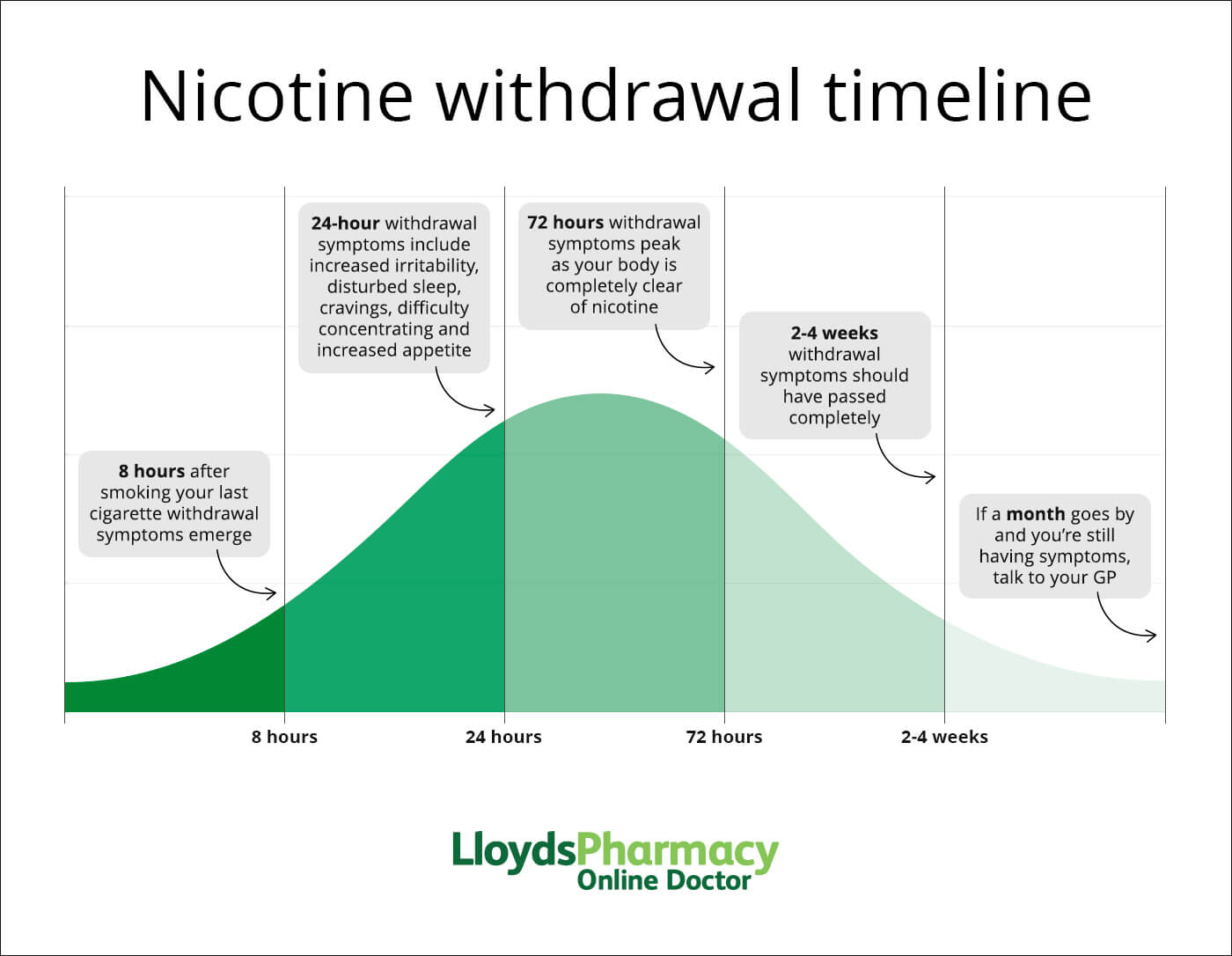Understanding withdrawal symptoms when quitting smoking
Reviewed by Dr Bhavini Shah
Quitting smoking can be one of the hardest things you do. It takes a lot of determination to get through nicotine withdrawal. In this article we’ll explain the nicotine withdrawal symptoms you could experience and how you can manage them. As well as the ways you can stop smoking for good.
What is nicotine withdrawal?
Nicotine withdrawal refers to the physical and psychological symptoms that happen when someone who has been regularly using nicotine suddenly reduces or stops using it.
Nicotine is a highly addictive substance found in tobacco products like cigarettes. When you stop smoking or vaping nicotine you experience a range of withdrawal symptoms as your body and brain adjust to functioning without it. These symptoms can make it really difficult to quit smoking.
Nicotine withdrawal symptoms
When you stop using nicotine products, you’ll experience nicotine withdrawal. During this time, you’ll more than likely experience a range of symptoms. These can vary in intensity and so can how long they last. These may be physical, mental, or a combination.
Physical symptoms
When you stop having nicotine your body goes into withdrawal, physical symptoms can include:
- Feeling hungrier which can lead to weight gain
- Trouble sleeping
- Coughing
- Sore throat
- Headaches
- Dizziness
- Being jumpy or restless
- Constipation
- Diarrhoea
- Tingling hands and feet
“Nicotine withdrawal symptoms can be uncomfortable and challenging but typically improve over time. If these symptoms are particularly uncomfortable or persistent, speak to a pharmacist or doctor.” Dr Bhavini Shah
Mental, emotional, or behavioural symptoms
Nicotine withdrawal can influence our mental wellbeing; our mood, how we think and function. These symptoms are often the most challenging aspects of quitting nicotine, they can include:
- Cravings for nicotine
- Urge to smoke/vape
- Anger
- Irritability
- Anxiety
- Difficulty concentrating
- Low mood and depression
“Support from family, friends, and healthcare professionals can improve your chance of quitting smoking and managing withdrawal symptoms. If you think you’re experiencing depression speak to your GP.” Dr Bhavini Shah
What is the nicotine withdrawal timeline?
Withdrawal symptoms can start as soon as you’ve had your last cigarette or vape. How intense they are and how long they last depend on how long you’ve smoked and how much.
In the beginning withdrawal symptoms may be strong but they will ease. You’ll also experience positive symptoms too. In just 48 hours your sense of smell and taste will improve.
See when nicotine withdrawal peaks with the stop smoking timeline:

Can nicotine withdrawal be prevented?
One study found that 61% of current smokers experienced withdrawal symptoms when they tried to quit. So, it’s more than likely that you will when you quit. It’s these symptoms that make smoking hard to quit and why many people relapse.
While you can’t prevent withdrawal symptoms, you can have a plan to tackle them. Use stop smoking treatments, lean on friends and family for support and plan to avoid triggers as this can also help to lessen cravings. The are also treatments available to help you stop smoking including NRT.
Nicotine replacement therapy (NRT)
Many people can quit by going cold turkey, but some smokers will be more successful with more support. There are different options to choose from to help you quit smoking. It’s about finding what works for you. You’re more likely to quit when using NRT, which includes:
- Nicotine patches which release nicotine slowly throughout the day
- Gum, mouth sprays and lozenges that give a quick release when cravings hit
- Prescription-only treatments such as cytisine and varenicline - these don’t contain nicotine. They help ease the effects of nicotine withdrawal and reduce cravings. Find out more about the differences between cytisine and varenicline.
- Vapes – less harmful thank smoking and only recommended to help smokers quit
Coping with nicotine withdrawals
Nicotine withdrawal can be challenging, but there are things you can do to cope. Alongside NRT or prescription treatments you could also try:
- Counselling or support groups
- Quitting with friends or family members
- Gradually reduce your nicotine intake over time rather than going ‘cold turkey’
- Exercising regularly
- Eating a balanced diet, if you’re hungrier choose healthy snacks
- Getting enough sleep
- Yoga, meditation or breathing exercises
- Avoiding situations, people and places that make you want to smoke
- Staying hydrated which can help with headaches
- Distracting yourself with a new hobby
Combining these coping strategies will help you to ignore cravings and successfully quit.
Conclusion
Giving up smoking is one of the best things you can do for your health. But it can also be tough. Nicotine withdrawal symptoms can be hard, and cravings may be intense. But you don’t have to go it alone and there are lots of ways to deal with nicotine withdrawal symptoms including stop smoking treatments.
References
https://www.cdc.gov/tobacco/campaign/tips/quit-smoking/7-common-withdrawal-symptoms/index.html
https://smokefree.gov/challenges-when-quitting/withdrawal/managing-nicotine-withdrawal
https://pubmed.ncbi.nlm.nih.gov/4091070/
https://www.nhs.uk/better-health/quit-smoking/
https://www.ncbi.nlm.nih.gov/pmc/articles/PMC9880314
https://www.sciencedirect.com/topics/medicine-and-dentistry/nicotine-replacement-therapy





